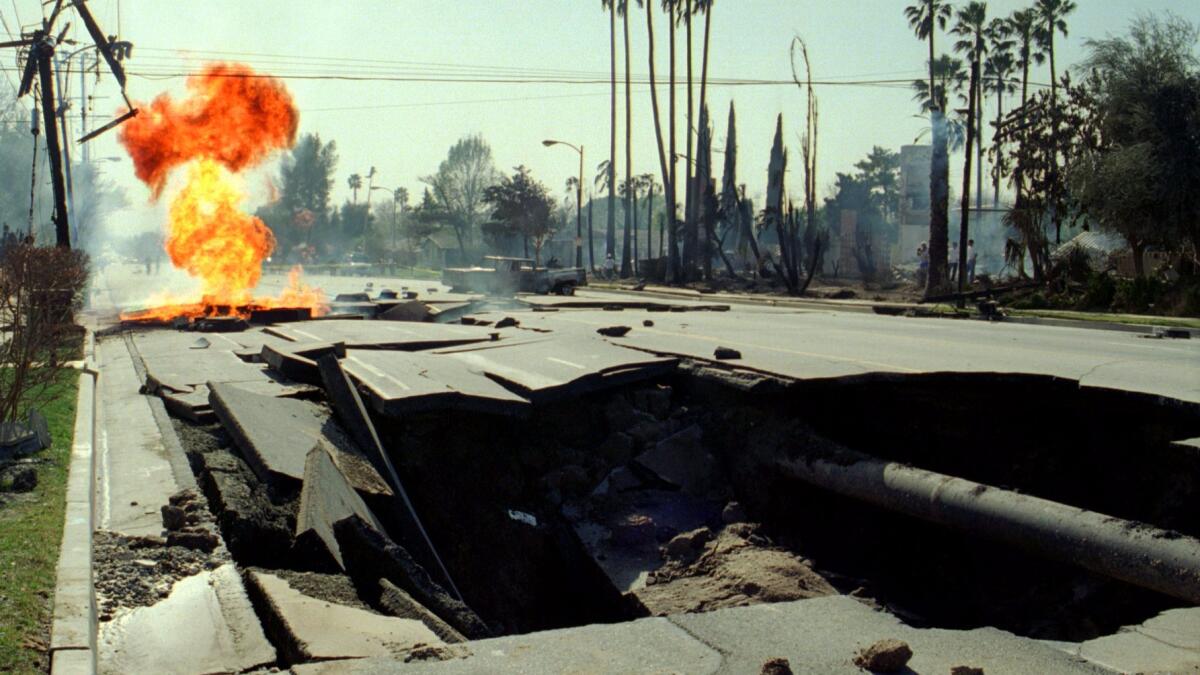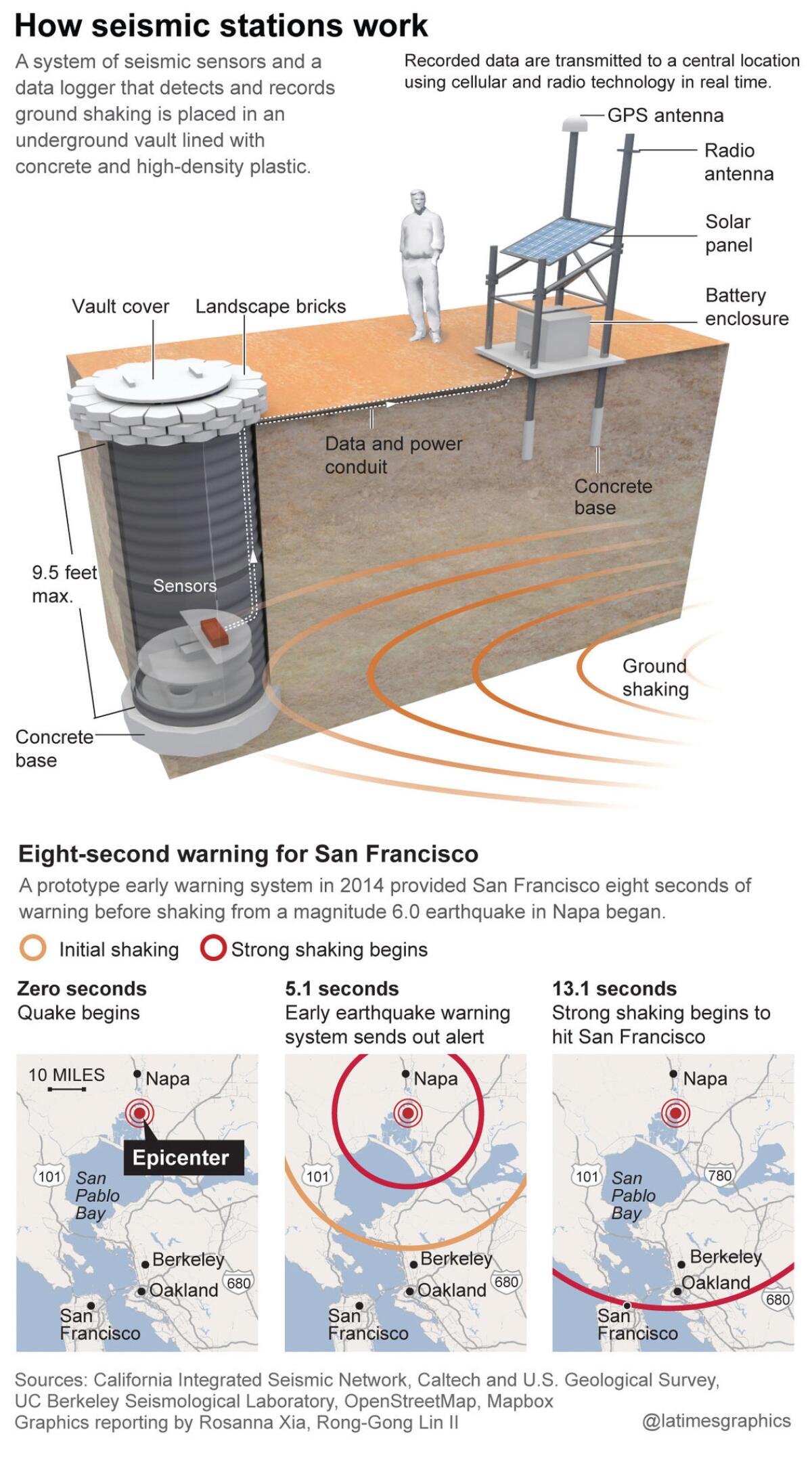Gov. Jerry Brown switches course, seeks $10 million in state funding for California quake warning system

- Share via
In a major reversal, Gov. Jerry Brown is seeking state funds for a fledgling earthquake early warning system for California, which would allow for a limited rollout of alerts by 2018.
The governor has supported creation of the system, which can give as much as a minute of warning before shaking from a big earthquake hits urban areas. But until now, Brown and the state Legislature opposed providing funds from the state’s budget, arguing instead the money should come from only private and federal sources.
Brown changed his public stance in his revised state budget, asking the Legislature to allocate $10 million toward the system, which is being developed by the U.S. Geological Survey and university researchers.
Even though California is in earthquake country, it has fallen far behind other areas including Japan, Mexico and Taiwan in developing an earthquake warning system. The network for California and the rest of the West Coast has been repeatedly delayed because of a lack of funding.
“This is going to be a huge boost to the build-out of the system. The infusion of state funding will allow us to surge forward,” said Doug Given, the U.S. Geological Survey’s earthquake early warning coordinator. “We have the intent of doing limited public rollout by 2018.”

A limited rollout of the system in two years would mean that places such as classrooms, offices, shopping malls, amusement parks and police and fire stations could have ready access to alerts that would give seconds, and perhaps more than a minute, of warning before strong shaking comes in a big earthquake.
Even seconds of warning to drop, cover and hold on would save many lives in an earthquake. Beyond that, alerts would give doctors time to halt surgery and would instruct trains to slow down, preventing deadly derailments. Eventually, bigger benefits are expected: technology to open elevators at the next floor, sparing occupants from being trapped, and warnings that could halt the flow of natural gas through major pipelines, preventing catastrophic fires.
Ultimately, scientists plan to develop apps for mobile phones and computers that would give the public the early alerts.
See the most-read stories this hour >>
The early warning system works on a simple principle: The shaking from an earthquake travels at about the speed of sound through rock — slower than the speed of today's communications systems. That means it would take more than a minute for, say, a magnitude 7.8 earthquake that starts at the Salton Sea to shake up Los Angeles, 150 miles away, traveling on the state’s longest fault, the San Andreas.
I think we're now on track to get this system up and running.
— Rep. Adam Schiff (D-Burbank)
The prototype system has had some early successes. When a magnitude 6.0 earthquake hit Napa in 2014, the system gave researchers in San Francisco about eight seconds of warning before shaking began. Earlier this year, 30 seconds of warning reached downtown L.A. before the ground shook from a magnitude 4.4 quake centered near Banning.
Brown’s decision marks a dramatic turnaround in fortunes for the warning system. Though the U.S. Congress and President Obama have kicked in millions for a West Coast system — most recently, $8 million for the current budget year, with another $8 million requested for next fiscal year that begins in October — officials in California, Oregon and Washington state had refused to make contributions from their own operating budgets.
Until now, California was particularly conspicuous in failing to contribute money to the system, since the state represents such a large share of the nation’s earthquake risk. Brown signed a law in 2013 calling for the creation of an earthquake early warning system, but the bill also explicitly prohibited the use of state general fund money to pay for it.
That prohibition expires on June 30. H.D. Palmer, a spokesman for Brown’s Department of Finance, said the time had come to give a jump-start to the system.
First public test of earthquake alert system rolls out at L.A. school >>
“The benefits of having even a minimal amount of warning time can provide a significant amount of ability to respond quickly,” Palmer said.
Mark Ghilarducci, director of the governor's Office of Emergency Services, said Brown has been tracking development of the network and believed now “was a good time to get some catalyst funding from the state to get this kicked off.”
The system “can reduce the impact of a major earthquake and allow more rapid recovery,” Ghilarducci said. “We're very excited about it. We think this is one of our legacy programs. For a state like California, this will really bring a great benefit in the long run.”
Already, Universal Studios has been studying how it would use earthquake early warnings at its campus. A fire station has tested how garage doors could open up automatically before the shaking begins, preventing the doors from being jammed by the earthquake. Warnings have been piped into science classrooms at Eagle Rock High School in Los Angeles, and trains on the BART commuter rail system in the San Francisco Bay Area are already programmed to slow down before shaking arrives.
This is going to be a huge boost to the buildout of the system. The infusion of state funding will allow us to surge forward.
— Doug Given, U.S. Geological Survey earthquake early warning coordinator
Technological limitations with mobile phone service, however, mean that reliable warnings over the cellphone system could take a few more years to be a reality. The U.S. cellphone network isn't built for mass alerts where seconds matter, and a bottleneck makes it difficult to send a message to millions of people at the same time, Given said. It could be three to seven years before a solution is reached here.
A solution, however, is possible; early warnings are available by cellphone in Japan.
Though the governor’s proposed funding is a big step for the system, it does not come with ongoing funds to operate it. An earthquake early warning system for California alone will cost about $23 million to build and $12 million annually to operate; if Oregon and Washington are added in, the initial construction cost rises to $38 million, and the yearly cost to maintain it would be $16 million.
“The proposed California funding, if approved, is important and very welcome because it will allow a rapid build-out of the ShakeAlert system in the state. But it won’t allow us to set an open-for-business date if it’s one-time funding,” William Leith, the USGS senior science advisor for earthquakes, said in a statement.
Join the conversation on Facebook >>
Of the governor’s proposed $10 million, $6.875 million has been set aside for capital costs, such as seismic stations, GPS equipment, telemetry and microwave nodes, while $2.241 million is proposed to help educate people on how to properly react to alerts. The remainder of the money is to be used to figure out future financing and to pay for staffing.
Officials will also need to find more money to build out the entire network. The proposed money won't be enough to complete a build-out of the 1,115 stations needed across California; the state currently has about 470, mostly in highly populated areas around Los Angeles and San Francisco.
Too few sensors means that San Francisco could see slower warnings from a large San Andreas fault earthquake that starts in Humboldt and moves toward the Bay Area.
Los Angeles could also see delays in an earthquake that starts in Monterey County and barrels south along the San Andreas fault. At least four seismic stations need to detect an earthquake before an alert is triggered.
Rep. Adam Schiff (D-Burbank), who has championed federal funding of the warning system, praised Brown’s decision. He and others hoped it would encourage Oregon and Washington state to follow suit, and private industry to also contribute.
“We now have full buy-in from California and the federal government,” Schiff said in an interview. “I think we're now on track to get this system up and running.... With this increment of funding, and the additional federal funding we hope to get this year, it should be a matter of a couple of years before we can build this system out.”
NEWSLETTER: Get the day's top headlines from Times Editor Davan Maharaj >>
The Legislature is required to pass a budget by June 15.
Other countries have already developed earthquake early warning systems after devastating quakes killed thousands of people. Mexico City has had a system since 1991, built after a 1985 temblor killed at least 9,500 people.
Japan built a nationwide early warning system after the 1995 Kobe earthquake killed more than 5,000 people. When the magnitude 9 quake hit east of Japan in 2011, many people in Tokyo, 200 miles from the epicenter, had 30 seconds of warning that the shaking was coming.
ALSO
Watch what 'The Big One' on the San Andreas fault would feel like
San Andreas fault 'locked, loaded and ready to roll' with big earthquake, expert says
San Francisco proposes $8 million to find a fix for quake-vulnerable sea wall
Twitter: @ronlin
Sign up for Essential California
The most important California stories and recommendations in your inbox every morning.
You may occasionally receive promotional content from the Los Angeles Times.








